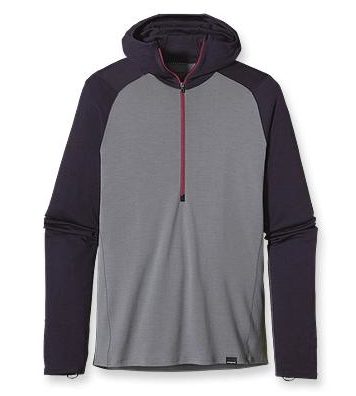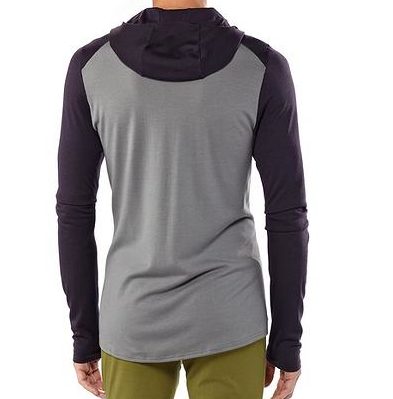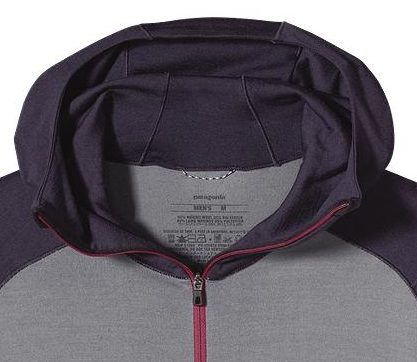
Patagonia Merino 3 Midweight Hoody
Size Tested: Medium
Reviewer Info: 6’0″, 190 lbs
Fit: Slim
Weight: 352 g / 12.4 oz
Material: 80% wool, 20% polyester
Features:
- 18.9 micron-gauge yarn; jersey-knit construction
- Hidden thumb loops on cuffs
- High collar and self-fabric hood with anatomical shaping
- Slow-washed without chlorine to prevent shrinkage
MSRP: $140
Days Tested: 15
Locations Tested: Craigieburn Valley, Mt. Olympus, Treble Cone, New Zealand
When selecting a baselayer, there are three primary factors that I consider: (1) materials (2) thickness/warmth, and (3) fit. I’ve also spent more time recently thinking about the efficacy of hoods on baselayers.
Merino Wool vs. Synthetics
First off, lets talk material. Before buying a baselayer, you have to decide whether you want wool, synthetic, or a blend of both.
- Synthetic
Many people say that synthetic materials, such as Patagonia’s Capilene, are more durable, wick better, dry faster, cost less, and are easier to wash than merino products. I’d personally agree with all of the above, especially when it comes to durability.
I have 15-year-old Capilene shirts that are as functional as they were when I bought them, yet I haven’t made it through a ski season yet without wearing out at least two pairs of lightweight merino tights and one or two shirts…
- Wool
Merino wool is a natural fiber that keeps you warm even when it’s wet, it wicks reasonably well, and it’s odor resistant. To me, the merino gear just feels warmer and more comfortable when I’m out sweating in cold weather.
Its odor resistance is an important feature for me. I sweat a lot, and my synthetic stuff is usually pretty smelly after a day or two of use. In contrast, I can get weeks worth of heavy wear from my merino gear without issue.
- Merino / Polyester Blend
Finally, there’s the merino / polyester blend. For the past few seasons, Patagonia has incorporated polyester into their merino baselayer line to increase durability. This year’s Patagonia merino baselayers, including the Merino 3 Hoody, are 20% polyester and 80% wool. Supposedly the wool pulls moisture to the inside of the fabric while the polyester wicks it away along the surface.
Based on my experience, I think the wool / polyester blend is more durable than the 100% wool products. I’ve found that I get 12-14 months of heavy use out of these blended fabrics before they become threadbare with holes. Even though they’re still not as durable as my old Capilene shirts, that’s about double the lifespan that I would have expected from a wool layer.
Odor resistance is also still excellent with the merino blends. I’ve been skiing and hiking in my Merino 3 Hoody every day for 2 weeks, and it still doesn’t smell bad.
Regarding wicking performance, I can’t speak for what happens on the molecular level, but the Patagonia blended baselayers are definitely my favorite pieces for high output activities in the summer or the winter—I just feel warmer and drier in them than I would in a Capilene or 100% wool layer.
The wool / polyester blend layers tend to keep their shape pretty well after repeated use. My old 100% merino gear often feels saggy or deformed after I’ve worn it a lot, especially if its wet. The merino / poly blend maintains its shape almost as well as Capilene products.
And one final note: the wool / polyester blend is easier to wash and clean. Patagonia recommends machine wash cold and tumble dry at low temperature for the Merino 3 Hoody. Other 100% merino products should typically be line dried. I’ve thrown many different 100% merino products into my dryer on low with varying degrees of success, and the wool / polyester blends seem to tolerate the heat much better.
So in sum, the comfort, durability, cleaning benefits, and odor resistance of the merino / poly blend are enough to nudge me almostly exclusive toward these baselayers.
Now time to talk about some specific features of the Merino 3 Hoody, which I’ve been testing while skiing in New Zealand over the past two weeks.
Weight
It’s a good weight for all-around mid-winter skiing and riding. I’ve extensively used Patagonia Merino 1 and Merino 2 weight clothing from the Spring 2013 line as well as 200 and 250 weight merino layers from Icebreaker.
For spring skiing or high output touring days, I prefer Merino 1 or 2 or Icebreaker 200. But for all-around use that involves stopping to set up photos, various forms of mechanized skiing, or other stop-and-go activities, the Merino 3 is a comfortable weight for me. It’s a bit thinner and softer than Icebreaker 250, but it’s much more substantial than their 200 weight.
Long ridge walks and boot packing at Treble Cone and at Mt. Olympus have been comfortable in a range of temperatures from low 20s to high 30s Fahrenheit with varying wind speeds.
Sizing
I personally have had a bit of a struggle with Patagonia sizing over the past few years, and it seems like they keep adjusting their fit.
I am 6’0”, 190 lbs., fancy jacket size 43, and two years ago, size medium Patagonia baselayers were skin tight but comfortable. Last year, some of the layers I tried felt quite small in a medium, but a bit too baggy in the large. This year, the medium Merino 1, 2, and 3 layers all fit me well, with ample sleeve length and shoulder width.
Fit
The hoody fits me well. I’m always annoyed when a baselayer isn’t long enough to cover my lower back while I’m playing outside and I prefer a fit that errs on the longer side. The Merino 3 Hoody is adequate in length, though I personally wouldn’t mind if the torso was a few inches longer. (The distance from the collar to the back of the hem on the back is 70cm.)

Hood
The biggest distiction between the Merino 3 Hoody and most of my other baselayers is the hood, which has its pros and cons. On the plus side, the hood is great for ski touring in variable weather, since it’s like having a hat attached to your shirt.
When I’m skinning all day I like to take my pack off as few times as possible, and to have everything I need for the uptrack ready at hand. Sweaty uphill slog? Keep the hood down and unzip the long front zipper to vent a bit. Stopping to wait for friends or notice a sudden dip in temp? Flip up the hood and carry on. My ice and alpine climbing buddies like this feature for similar reasons.
The hood also serves as a great faceguard and helmet / hat liner on deep pow days—I always wear a hooded baselayer for resort powder days for this reason. The hood on the Patagonia Merino 3 fits very well, and has a great collar height for this type of use.

Granted, having a hood means there’s extra fabric flopping around your neck when the hood isn’t on your head. I don’t usually notice this, but it is bothersome if I’m layered up on a cold day with lots of other hoods (e.g., windbreaker, puffy, shell). It’s also often not necessary. When I’m skinning up on a windy day, I usually have on my superlight, hooded windbreaker, and its hood is almost always adequate to keep me going without having to stop to put on a hat.
The good news is that if you don’t think you’ll want or need the hood, Patagonia offers essentially the same zip-neck shirt without one.
Durability
I would assume that the Merino 3 Hoody is more durable than the Merino 1 and 2 layers given it’s additional thickness. I have not worn it long enough to really address durability, but I will certainly update this review if I experience any issues.
Bottom Line
Overall, my favorite types of baselayers are made from merino / polyester blend fabrics. And this particular Patagonia Merino 3 Hoody fits well, has a functional hood, and is a good weight for all-around snowports use.
